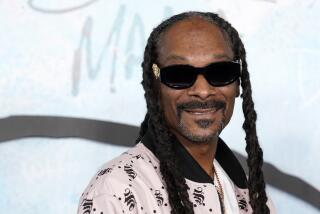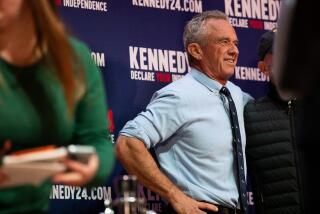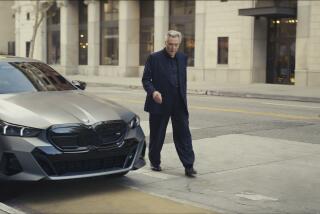New Matchup at Super Bowl: Coke and Pepsi
In the Super Bowl of advertising, it is Coke vs. Pepsi.
The soft drink rivals are airing competing TV ads in Sunday’s game for the first time since 1991, in a contest as pitched as any on the field.
Pepsi said Tuesday that it plans to air six spots introducing its slogan “Generation Next,” reaching out to those who remember the “Pepsi Generation” of the ‘60s while updating the old slogan for the youth of today.
In getting back to its roots, Pepsi is using glitzy celebrities and images of trendy young people--a departure from Pepsi ads of the last two years that relied on warmth and wit. One 60-second spot is a fast-paced montage of Generation Xers, including a gold-painted woman with the red, white and blue Pepsi globe on her fingernails.
Commercials from Coca-Cola are still under wraps. The company will be using the Super Bowl to pitch Diet Coke and Surge, a new soft drink aimed at Pepsi’s highly successful Mountain Dew.
As the best-watched event of the year, the Super Bowl is an advertising showcase. Advertisers paid a record $1.2 million for a 30-second spot during this year’s game, and millions more to produce attention-getting commercials.
“We are delighted to go head to head with Coke,” said Pepsi marketing chief Brian Swette. “We find it kind of ironic that the official NFL sponsor never showed up for the big game. We want consumers to make the comparison in product and attitude.”
Coke has stayed out of the Super Bowl in recent years, saying it prefers events where it can dominate the commercial lineup. It previously sponsored Super Bowl specials on cable TV, for example.
But this year it is using the game to introduce Surge in about half the country. Cities where Surge won’t be introduced will see Diet Coke spots.
Coke spokesman Mart Martin downplayed the ad wars with Pepsi.
“Our appearance in the Super Bowl is not to go up against Pepsi, but to use the event as a tremendous stage,” he said.
Pepsi has invested heavily in its commercial lineup, with a star-studded cast that includes Los Angeles Laker player Shaquille O’Neal; supermodels Cindy Crawford, Tyra Banks and Bridgette Hall; TV actor Michael J. Fox; and music by Isaac Hayes and the Village People.
The liberal use of celebrities is probably a smart move, according to Bruzzone Research Co., a consulting firm in Alameda. It found that the best-remembered Super Bowl commercials between 1992 and 1995 featured famous people. Leading the list was a 1994 Pepsi commercial with O’Neal.
Even so, Pepsi marketing chief Swette insists the company hasn’t built its campaigns around stars.
“This isn’t a celebrity campaign,” said Swette. “We are using them to enhance an idea.”
The company’s lavish commercials signal the intensity of the soft drink competition. Though PepsiCo Inc. has made recent gains in market share, it is not close to unseating Coca-Cola Co. as the industry leader. Coca-Cola had 43% of the domestic market in 1995, according to the Beverage Marketing Annual Industry survey, compared with 30.6% for PepsiCo.
On Tuesday, Pepsi reported domestic beverage sales gains of 5% for the fourth quarter of 1996, thanks in large part to packaging innovations such as the “cube,” a carton containing four six-packs, which entices consumers to buy more.
Pepsi also released figures indicating that it had gained on Coke in supermarkets and convenience stores. With the final weeks of the year not tallied, Pepsi had captured 17.9% of soft drink sales, compared with 17.8% for Coca-Cola. Those figures do not reflect fountain sales, where Coke is far ahead of Pepsi.
Beverage industry analysts said Pepsi’s new slogan, with its emphasis on youth, should help energize the brand. The previous slogan, “Nothing Else Is a Pepsi,” did not convey a youthful outlook, they said.
“Energy of youth is the touchstone of the brand, and it was what distinguishes it from Coke,” said Tom Pirko, president of Bevmark LLC, a consulting firm.
Pepsi said it planned to use the slogan internationally, where the company has suffered recent setbacks, to lay claim to the global youth culture. “Nothing Else Is a Pepsi” was not suitable for use worldwide, Swette said.
(BEGIN TEXT OF INFOBOX / INFOGRAPHIC)
The Soft Drink Bowl
For the first time in five years, advertisements for Coke and Pepsi products will compete for viewers’ attention during Sunday’s Super Bowl. Meanwhile, advertising rates for a 30-second commercial during the game remained flat this year.
MARKET SHARE
*--*
1990 Coca-Cola 40.4% 1990 PepsiCo 31.1% 1900 Dr Pepper/Seven-Up* 14.5% 1990 Other 14.0%
*--*
*
*--*
1995 Coca-Cola 43.0% 1995 PepsiCo 30.6% 1905 Dr Pepper/Seven-Up* 16.1% 1995 Other 10.30%
*--*
* Both owned by Cadbury-Schweppes.
*
Ad Rates
Cost of 30-second commercial, in millions
*--*
Year Cost 1997 $1.2 1996 1.2 1995 1.0 1994 .900 1993 .850 1992 .800 1991 .800 1990 .700 1989 .675
*--*
Source: Beverage Marketing Annual Industry Survey; Times reports
Researched by JENNIFER OLDHAM / Los Angeles Times


